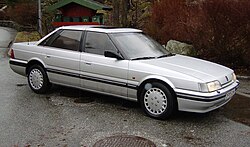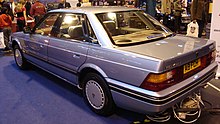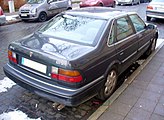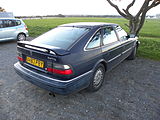Rover 800 series
| rover | |
|---|---|
|
Rover 827 notchback (1986–1991)
|
|
| 800 | |
| Production period: | 1986-1999 |
| Class : | upper middle class |
| Body versions : | Sedan , station wagon , coupé |
| Engines: |
Otto engines : 2.0–2.7 liters (74–145 kW) Diesel engine : 2.5 liters (87 kW) |
| Length: | 4882 mm |
| Width: | 1730 mm |
| Height: | 1393 mm |
| Wheelbase : | 2760 mm |
| Empty weight : | 1395-1425 kg |
| Previous model | Rover SD1 |
| successor | Rover 75 |
The Rover 800 series was an upper middle class passenger car series offered by the MG Rover Group and manufactured from the summer of 1986 to the beginning of 1999. They were available as a notchback, hatchback and, from 1992, also as a coupé. The Rover 75 came onto the market as a successor model .
development
Partnership with Honda
The Rover 800 was intended as a successor to the aging Rover SD1 . The car was developed in the early 1980s in technical cooperation with Honda under the internal code "XX". The corresponding Honda version was called Honda Legend and was internally referred to as "HX". Common to both cars was the floor pan and body structure, the chassis, axles, gearboxes and the V6 engines. The gearboxes for the four-cylinder in the Rover 820 were also a Honda development and were built in England together with the gearboxes for the 825/827 and Legend. The two-liter engines of the Rover were in-house productions by Austin-Rover and further developments of earlier series. The Rover 800, like the first series of the Honda Legend for the European market, was manufactured in the former Morris factory in Cowley near Oxford . Honda manufactured the Rover models in Japan for the Pacific-Asian market.
From a technical point of view, the car was much more complex than its predecessor. The basic version of the 800 had a 2.0 liter 16-valve engine with 74 kW (100 hp), which was developed from the robust O-series by British Leyland and called the M-series. The cars were sold in England as Rover 820 models with single-point injection (in the 820e) and 88 kW (120 hp) and four-point injection MPi (in the 820i) and 98 kW (133 hp). In Germany these were only sold as MPi injectors with regulated catalytic converters.
The top-of-the-line Rover 825 had a V6 engine built by Honda in Japan with a displacement of 2.5 liters and 24 valves. This was increased to 2.7 liters displacement in 1988 in order to compensate for an existing lack of torque at low speeds. The original versions were sold in Germany as 2.5 liters with a catalytic converter and 110 kW (150 PS), while the 2.7-liter engine achieved 117 kW (169 PS). The models without a catalytic converter developed 122 kW (166 hp) with an automatic and 127 kW (173 hp) with a manual transmission.
A diesel engine with a displacement of 2498 cm³ and 87 kW (118 hp) was delivered in 1990 by VM Motori . This engine was also found in other vehicles such as the Jeep Cherokee and in some Range Rover models. In Germany this was offered for a short time from 1992.
The Sterling on the American market was only available with the V6 engine; in Europe, models with the “Sterling” designation were the best-equipped version. In the second series of the 800 series, the Rover T-series engine, which had been on the market since 1990, was used from 1992, which had a turbo output of 145 kW (197 hp). This model was not available in Germany. In England it was sold as "Vitesse" and in other European countries as 820 ti. The engine also played a role for Rover from a marketing point of view: it contributed to selling the car with corresponding performance in markets such as Italy, the Netherlands and France, where cars over 2.0 liters displacement are subject to a luxury tax , which also included the versions with 2.5 and 2.7 liters displacement.
The vehicles of the first series, which were produced up to autumn 1991, were offered under a brand founded especially for the USA: Sterling Motor Cars , which formed the re-entry of the brand in the USA. The cars were sold separately from Range Rover models through ARCONA (Austin-Rover-Corporation of North America), a sales company established in Miami to reintroduce Rover automobiles to North America. This form of distribution was only practiced until 1990 due to its only moderate success.
The "Vitesse" models were only available in Germany in the first series and only had the 2.7l V6 engine in conjunction with the five-door hatchback variant. In England these versions were available for the XX and R17 series, later in conjunction with the Rover turbo engine. With the introduction of the new model in autumn 1991, this designation, like the name "Sterling", was no longer retained on the German market.
The driving behavior of the Rover 800 was characterized by the front suspension with double wishbones, so that compared to other cars in the upper middle class, it had a relatively small spring travel with limited driving comfort. It was inevitable that the expectations of customers as well as the trade press would be disappointed, as the vehicle was to compete with sporty models such as the BMW 5-series , the Alfa 164 and the Saab 9000 .
The production and individual component quality in the early days of the Rover 800 was inadequate and had a dubious reputation. For example, there were problems with moldings, the electrics / electronics and the paintwork. Corrosion problems on the early models also initially influenced the image. The fact that the Sterling brought up the rear in the JDPower satisfaction study, while its sister model, the Acura Legend built in Japan for the USA , took one of the top places in its first year of sales, made further sales to a luxury customer segment difficult .
All of this, in addition to the ever-increasing pound, made cars less attractive to Americans and ultimately only made Rover losses. Since they were unable to keep up with the discount business of the American brands and the yen-based pricing of the Japanese manufacturers (Infiniti, Lexus & Acura) in the long run, Rover's second attempt to gain a foothold in the USA ended with one another withdrew from the US market in the summer of 1990.
In the spring of 1988, the 2.5-liter machine was drilled out to 2.7 liters, the unreliable fittings from the Austin Maestro in the 2.0 were replaced by Honda components from the V6, and overall manufacturing quality was improved. The facelift and quality improvement measures came too late, however, to save him from being discontinued in view of the poor sales figures in America.
Facelift
1991
In October 1991, the 800 (under the code name "R17") was fundamentally revised. It received a traditional Rover grille, reminiscent of models from the 1950s and 1960s, and a more rounded body shape. The revision affected the bonnet, bumpers, rear lights and the rear side panels, which made it possible to increase the rear and lead to an increase in the volume of the trunk. The third side window has also been enlarged and raised. The front and rear of the car received new bumpers and the hubcaps a new design. The fenders have also been modified.
In the interior, the dashboard was modernized, the on-board computer of the predecessor gave way to new, very dark wooden surrounds in the center console, and all of the wood paneling was revised.
From spring 1994 there was also a passenger airbag, and the design of the seats was redesigned. At times, a sporty interior with Recaro seats was also available.
The revision turned out to be a design challenge, as the previous body structure, including the passenger cell and door components, had to continue to be used. The renewal of the styling also led to a significant increase in sales, as the Rover 800 was the best-selling upper mid-range vehicle in Great Britain in the mid-1990s.
The terms "Vitesse" and "Sterling" from the previous model were no longer used in Germany. The new models were called 820 i, 820 Si, 827 i, 827 Si and at times 827 SLi. A diesel version followed, the 825 SD or SDi.
The turbo models were not available in Germany. In England these were sold with the designation 820 Vitesse, in all other European countries as 820 Ti. The paint quality had also been significantly improved at this time, so that corrosion problems had largely been eliminated.
Coupe
In August 1992, the two-door coupe version of the Rover 800 appeared.
It was originally developed with the previous model for the American market, but only made its debut in the style of the second series. It was manufactured as a niche model in small series and sold in other European countries as the top model by Rover, with 80 percent of the coupé being assembled by hand.
While the 800 coupé was only available on the German market with the 2.7 liter V6 of the Honda Legend as the 827, in England and other European countries there were also 2.0 liter versions with turbo and 145 kW (197 hp) and without turbo with 100 kW (136 PS).
1996
The second facelift carried out in April 1996 included only minor changes to the exterior of the vehicles; the most noticeable feature were some previously black moldings on all models (except the coupé), which were now painted in body color, and the revision of the wheel suspensions. In addition to the basic “i” model, the standard equipment has been supplemented with automatic air conditioning, an immobilizer, a passenger airbag and a six-disc CD changer. Wood paneling was used more generously, and the "ROVER" lettering was incorporated into the wood paneling of the front doors; the seat covers were of higher quality.
At the same time, the Rover KV6 engine mentioned at the beginning also made its debut, with a displacement of 2.5 liters and an output of 129 kW (175 hp). It arose from the expansion of the multiple international award-winning Rover K-series engine, which now had two more cylinders. The new top engine was 14 percent more economical than the Honda machine, had more torque at lower speeds and, according to a press release from Rover Germany, worked quieter and smoother. These engines were built by hand, as the car was only manufactured in small numbers and only a small number were equipped with KV6 engines. However, this obviously had no effect on the durability of the engine, the problems of which only stopped with the start of serial production for the successor Seventyfive.
Although the 800 lost significant ground to its competitors' younger competitors (apart from the introduction of the Rover KV6 machine in 1996, there were only a few technical changes), it sold well until the end of production in February 1999.
Then the Rover 75 presented in autumn 1998 took over the position of the 800 series.
Motorsport
On June 6, 1990, Tony Pond set a new track record for automobiles on the well-known Isle of Man Tourist Trophy course with a slightly modified Rover 827 Vitesse with an average of over 100 mph (160 km / h) for the first time, which was only set in June 2011 was beaten.
Buyer of the vehicle
Well-known buyers were Neil Hamilton , Peter Mandelson , Clement Freud , Max Bygraves and Michael Parkinson . The model was part of the British government vehicle fleet, which traditionally consists of native Rover and Jaguar models, throughout its construction period. Rover 800s were also used in the royal family's fleet. So you could see in the news or reports of the 1980s and early 1990s that z. B. Princess Diana , Prince Charles , Princess Anne and other members of the Royals were chauffeured in the Rover 800 on various occasions.
The car was also frequently ordered by the police, specifically as a high-speed patrol car, as the Series II turbo engines reached high speeds. Alan Partridge (played by Steve Coogan ) drove a Rover 800 in the comedy series Knowing Me, Knowing You… as well as in the first episode of the series I'm Alan Partridge . The Rover 800 also made an appearance on TV that can be seen worldwide Series Dallas . In the final season, which aired in 1990, actress Kimberley Foster drove a white sterling in the role of "JR Ewing" daughter-in-law "Michelle Stevens". Over the past few years, the Rover 800 has repeatedly been featured as an emergency vehicle for the English police in crime series such as Fitz For All Cases , Inspector Barnaby , Forensic Doctor Dr. Samantha Ryan et al. a. see.
Production numbers
| 1986 | 15,609 |
| 1987 | 54,434 |
| 1988 | 48,634 |
| 1989 | 35,387 |
| 1990 | 29,460 |
| 1991 | 10.007 (before the facelift) |
| 1991 | 2961 (after the facelift) |
| 1992 | 28,136 |
| 1993 | 28,354 |
| 1994 | 21,802 |
| 1995 | 13,311 |
| 1996 | 11,400 |
| 1997 | 11,131 |
| 1998/1999 | 6,500 |
Model data
Unlike other manufacturers who use numbers for their model names, there has never been a consistent logic for the type designations at Rover. During the cars developed in cooperation with Honda (1989–1995), the model types such as BMW or Volvo were first named with a general model number and then with an indication of the cubic capacity.
In the case of the Rover 800, the 8 stands for 8 series and the following numbers indicate the displacement. So a Rover 820 had a displacement of two liters.
- 820: two-liter four-cylinder (8V) with carburettor and 74 kW (100 hp; 10/1988-10 / 1991)
- 820 e: two-liter four-cylinder (16V) with central injection and 88 kW (120 PS; 10 / 1986-10 / 1991)
- 820 i / Si: two-liter four-cylinder (16V) with multi-point injection and 104 kW (140 PS; 10 / 1986-10 / 1988) or 98 kW (133 PS; 10 / 1988-10 / 1991)
- 825 i: 2.5l six-cylinder (24V) with 127 kW (173 PS) or 110 kW (150 PS) with catalytic converter (01 / 1987-10 / 1991)
- 827 i: 2.7l six-cylinder (24V) with 130 kW (177 PS) or 124 kW (169 PS) with catalytic converter (02 / 1988-10 / 1991)
- 825 D / SD: 2.5l four-cylinder diesel (8V) with 87 kW (118 PS; 01 / 1990-10 / 1991)
After the facelift in October 1991, the name was simplified:
- 820 i: two-liter four-cylinder (16V) with multi-point injection and 100 kW (136 hp; 10/1991–02/1999)
- 820 Ti: two-liter four-cylinder (16V) with turbocharger and 145 kW (197 PS; 01 / 1992-02 / 1999)
- 827 i: 2.7l six-cylinder (24V) with 130 kW (177 PS) or 124 kW (169 PS) with catalytic converter (10/1991-04 / 1996)
- 827 i: 2.7l six-cylinder (24V) from Honda with 129 kW (175 PS; 04 / 1996-02 / 1999)
- 825 SD / SDi: 2.5l four-cylinder diesel (8V) with 87 kW (118 PS; 10 / 1991-02 / 1999)
From April 1996 there were no more cubic capacity designations and all models were uniformly called "Rover 800".
These designations did not contain any additional letters to designate the equipment variant, such as the earlier combinations with "S" and "L" z. B. "825 SD" or later "825 SDi".
Conversions
A number of coachbuilders, including Coleman Milne and Startin , built hearses based on the Rover 800 or extended the cars. At Startin and its successor MacNeillie & Son , around 300 copies of the long limousine known as the Rover Regency were made, which were available in the first series with four and in the second series with six doors.
Web links
- Evolution of the Rover 800 Series (English)
Individual evidence
- ↑ http://www.rallye-magazin.de/r/int/d5/n5/d/2011/06/07/higgins-bricht-rekord/index.html ( page no longer available , search in web archives ) Info: The link was automatically marked as broken. Please check the link according to the instructions and then remove this notice.
- ↑ James Taylor: Rover 800 Series: The Complete Story . The Crowood Press, 2016, ISBN 9781785002250 .











